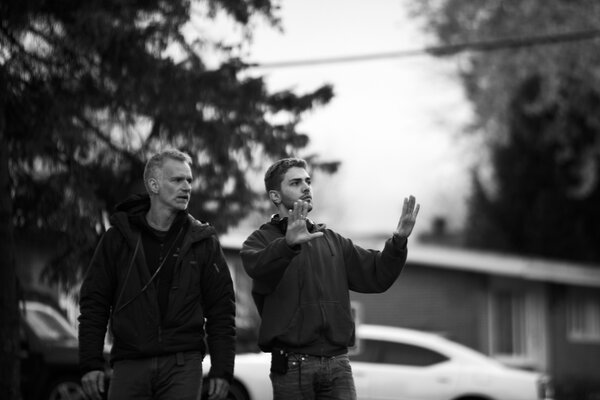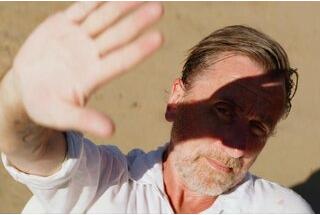Conversation with cinematographer André Turpin about "Mommy", directed by Xavier Dolan
His career as a cinematographer is based on a true collaboration with Denis Villeneuve for Un 32 août sur terre (32nd Day of August on Earth), Maelström (Jutra Award of the best photographic direction) and Incendies (Genie Award and Jutra Award of the best photographic direction). He also worked with Philippe Falardeau for C’est pas moi, je le jure ! (It’s not me, I swear !) and Congorama. His partnership with Xavier Dolan started with Tom à la ferme (Tom at the farm) and for the fifth feature film of this young filmmaker from Quebec called Mommy, we interviewed André Turpin as he was nominated for the official selection on the Boulevard de la Croisette in Cannes. (BB)

Did this second film with Xavier Dolan represent the opportunity to extend the continuity in the conception of the image ?
André Turpin : No, not at all ! Mommy is completely different, as a film concept on the one hand and as a shooting condition on the other hand. It’s really the opposite ! Tom à la ferme (Tom at the farm) is a parenthesis in Xavier’s works. Mommy is much more vivid in terms of form and light.
The story is tragic but Xavier did not want us to be miserabilist. He wanted the characters to be considered as heroes, even if they are lost, to be brightly coloured so that the form reinforces their personalities because they love and hate each other throughout the film !
So you created a strong contrast lighting ?
AT : Yes, it’s rather contrasting, rather saturated and very much coloured. It has been a long time that I’ve used such a colourful lighting ! We tried out a lot of colours with quite warm lighting, ambient mauve and pink lighting and a mix of light I was never used to.
When testing, I made my key light with a 3.200 K projector which I warmed up with ½ CTO or CTS, and my fill light with pink. When I removed my pink lighting effects and left the white reflector, I suddenly felt the white reflection in the face which usually is not perceptible.
When comparing both images I noticed that the "white" version was really white in the reflections and the shadow zones. The pink that was not perceptible gave depth to these shadow and reflection zones. This is obtained naturally in the twilight with the bluish sky and the orange low-angled sun, but why not producing it elsewhere, with other colours !
Did you evoke references with Xavier Dolan for the visual universe of Mommy ?
AT : The references for this movie greatly come from fashion and above all from photographs. Concerning the movies, it were essentially films by Scorsese or other very vivid and unusual movies of the 1990s. Regarding the directions of light and the contrasts, I often had precise references of fashion photographs.
You shot in 35mm and in a very special format ! Can you explain your choice ?
AT : Yes, the format is quite special and I think it’s a première in film history ! We shot in square format 1:1, like a CD cover. It’s the ideal portrait format. We’ve shot a clip of the band Indochine, College Boy, which was censored by the way in France, and I suggested the 1:1 format to Xavier. And then, he fell in love with this format !
For some shots, the movie starts on 1,85:1 and then suddenly it’s great to discover this large image. But it only occurs twice, in particular for a liberation scene. When the drama carries on, the square format is back again.
It’s a very restricting format, very difficult to frame because when the characters are moving in chest shot you should be ready to reframe at any time, the actor does not have much space ! These frames really refer to the portrait in photography. I can’t wait to see this 1:1 projected onto the screen in Cannes with black bars at the side ! I’ve chosen the 35 mm giving me the possibility to take extreme pictures in the highlights and in colorimetry. From a technical point of view, we could say that there is a better digital image, with more latitude, but the result is even more unpleasant as regards to overexposure.
Did these very dynamic shots call for a particular light installation ?
AT : Xavier likes a very vivid camera and we used a steadicam every day. Yes, I had to install projectors on the ceiling or choose to light as much as possible by the windows and as little as possible inside…
The point that is a little bit frustrating is that the shot taken by steadicam passes from a wide shot to a close-up without cutting the camera. When coming to a close-up, there is always the regret not having been able to really control the image. We manage to work with an electrical engineer who is moving with the projector or a hidden gripper who quickly has to manipulate the reflector !
With this light constraint and above all due to the light entering from the windows, I often used Jo-Lekos (Joker Bug with a system of knives). I never work with direct light inside. For reflected light, instead of installing flags to control the quantity of light, this system on the Joker allows the same thing, but in a much more precise and faster way. And it saves a lot of space !
What kind of film and lenses did you choose ?
AT : I’m shooting with Kodak for a long time, in fact since the arrival of the 5219. Before I used Fuji. I started with the 5219 for Denis Villeneuve’s film Incendies. This film is really the summit of Kodak technology and it’s really sad that the film-based projection disappears.
I really saw the evolution of films and their technological and artistic culmination, but we won’t take advantage of them for many years to come... I’ve chosen Master Prime Zeiss lenses, very sharp-edged that I diffused sometimes with Low Contrast filters 1/2 or 1.
What were the advantages to turn this movie in two parts ?
AT : The first part takes place in autumn, the other part in winter. Xavier edits his films, so he edited between both shootings and thus got a better idea of the movie ; he even rewrote the second part. This break was also interesting for me.
Visioning the dailies teaches us a lot about the image, but when we see the film editing, we really become aware of the light and the shots we did not often use. For the second shooting we know what’s superfluous, we improve the light, the whole crew knows everybody, the characters have found their position, we can adjust the scenes.
The camera operator and I were a little bit frustrated always doing close-ups, but Xavier did not make a mistake because it really is an actor’s film, a portraits film. We saw that it worked when editing and so we were more relaxed during the second shooting. We should always shoot that way !
Did you choose a film for your next movie as a moviemaker ?
AT : Well, no ! Even in spite of all the advantages of the film I just mentioned ! I have two reasons to do so. The first reason is a good one : I will have a lot of displays for the image and the film, the visual rendering is never really successful, particularly for the colour and contrast control. The second reason is a bad one : something is frustrating me as a filmmaker, it’s the fact of not having access to a quality image on the film set.
When I do the framing myself, I see the image in the viewfinder and it’s perfect. As I will neither light, nor frame my film, I will need this quality image to see the light and the actors’ performance. I know that I will get this nice image with Alexa. I very much like this camera with which I shoot all the adverts that I light. We are in a transition phase, but I’m really confident for the digital future. And little by little I start to turn my back on the film grain, even though I was born with it !
(Interview conducted by Brigitte Barbier for the AFC, translated from French by Andrea Lemke)
 En
En Fr
Fr





